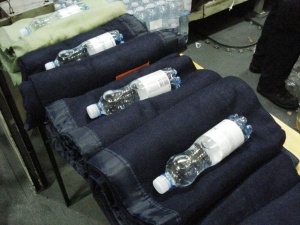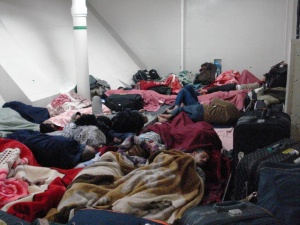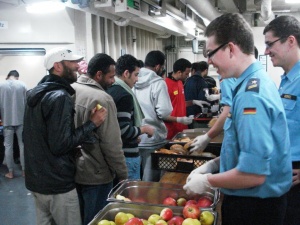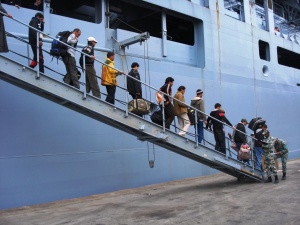
Report: W. Toepfer
Military evacuation operation ‘PEGASUS’
Humanitarian aid in TUNESIA in February/March 2011 – Medical service experiences from the point of view of the German Navy
During the revolutionary struggles in Libya in the spring of 2011 a German Naval Task Group secured the air evacuation of German citizens from this disputed territory from the sea using a naval rescue centre embarked. Several hundred Egyptian refugees were then taken aboard the ships and evacuated from Tunisia to Egypt.
Introduction
The evacuation of German citizens from Libya as a result of the escalating civil war in February 2011 was carried out by air in accordance with operational planning. A German Naval Task Group was massed off the Libyan coast in order to be able to evacuate the German citizens in the event that the air evacuation failed. The naval rescue centre of the participating combat support ship ‘BERLIN’ was activated in this connection. The medical treatmant facility at ROLE 2 was to provide surgical care to injured German citizens in the operations area. For this purpose, medical experts needed to be transferred to the theatre of operations and operational readiness on board ensured within only a few days.

The consequent fast evacuation of several hundred refugees from Tunisia to Egypt in March 2011 was new territory for the German Navy. It was the first time since the end of the Second World War that a large number of refugees was accommodated and looked after temporarily on board of war ships. Even if the number of refugees from the former German eastern territories was sometimes greater these people were mainly familiar with German culture and spoke the language. However for the humanitarian aid in Tunisia in March 2011 people were evacuated from a different cultural area with corresponding ethnic and religious backgrounds, without German and mostly also without English language skills. The number of allocated refugees exceeded the capacity of the available rescue materials and the available accommodation was insufficient. In addition to this it was not possible in the beginning to estimate the potential for violence of the refugees when accommodated on board en masse or the underlying diseases and individual treatments necessary and the hygiene risk for the crew.
Military evacuation operation ‘Pegasus’

As the revolutionary struggles in Libya escalated in February 2011 it became necessary for the German government to evacuate German citizens from the disputed territories. The ‘concept of operation’ planned the gathering of German citizens at meeting places and their transportation to Europe by air. The German Navy was to assure collection of the persons on the Libyan coast and their transfer by sea in the event that the air evacuation failed. For this purpose the ‘Operations and Training Task Group’ that was off the coast of Spain was moved to the Libyan coast as Task Group (TG) 501.01. The TG comprised the combat support ship ‘BERLIN’ and the frigates ‘BRANDENBURG’ and ‘RHEINLAND-PFALZ’. FGS ‘BERLIN’ has its own naval rescue centre, which is intended for the provision of emergency medical and primary surgical treatment for ROLE 2 as a medical treatment facility. As the facility was not manned at this time the corresponding specialist staff had to be massed in Germany on Friday, February 25th and flown to Sigonella / Sicily, where the augmentees were first taken on board FGS ‘RHEINLAND-PFALZ’ in the port of Catania and then transferred to FGS ‘BERLIN’ at sea on Sunday, February 27th using helicopters. The subsequent activation of the important areas in the naval rescue centre such as the trauma room, in-patient ward and operation room was carried out within 10 hours. This provided an immediate treatment capability for injured and sick persons. The initial operation of all other functional areas was completed within a further 24 hours. At this time all surgical sieves had been sterilised. This short time requirement, which is well below the periods needed for activation in previous operations, was mainly a result of the high level of material equipment in the different function areas of the inactive naval rescue centre, which stood the test particularly well in this case. As the evacuation of the German citizens was completely successfully by air TG 501.01 was dismissed from the mission on March 2nd, 2011.
Humanitarian aid TUNESIA
On March 3rd, 2011 the TG already received the unexpected follow-up order to evacuate Egyptian refugees from Tunisia to Egypt as part of the humanitarian aid programme. The refugees had been working in Libya as migrant workers and fled to Tunisia because of fighting. The situation in the refugee camps there was dramatic for the aid organisations. The camps were overcrowded, there was a shortage of clean water and the risk of the spread of diseases was rising steadily. In this situation the evacuation of refugees from the camps was a matter of priority to achieve a stabilisation of the circumstances.

The challenge for the units was to transport a large number of refugees with unknown existing illnesses from a foreign culture and almost without knowledge of any European language over several days and with a security risk that was difficult to calculate. The two frigates and the combat support ship were not conceived for this mission, particularly as the units had no free personnel accommodation at this time. On FGS ‘BERLIN’ alone 255 soldiers had been shipped in although the accommodation capacity was 231 bunk spaces and some were sleeping on the floor.
Immediately before reaching the Tunisian coast at anchor off Gabes / Port de Ghannouch the TG was informed of riots among the refugees on board of a civilian ferry that the refugees were using to force the ship to depart quickly. The ship’s masters had obviously lost control of the aggressive clashes on board. Because of this and other background informations the temporary accommodation of refugees on the ships of TG 501.01 with constant supervision and strict separation from the crew accommodation areas seemed to be the only alternative. The expected critical hygiene situation also demanded separation from the crew.
Separate spaces needed to be prepared for this purpose and separate transport and escape routes had to be created as well as communal areas sectioned off on the upper deck using suitable cordoning measures. In the same way like the hangar areas on the frigates were prepared for the refugees the provisions corridor for freight and 4 neighbouring loading rooms for ammunition and dry provisions needing to be cleared on board FGS ‘BERLIN’. The rooms were equipped with mattresses and blankets, which needed to be purchased on short notice, in order to create makeshift sleeping spaces. As the ventilation system in the freight rooms was not designed to supply fresh air to large numbers of persons a mobile fan that is used to remove smoke in the event of fire was quickly installed on the upper deck and this constantly delivered fresh air into the refugees’ communal areas at all times via a wide hose. It was less the noise that caused a problem here but rather the constant, cold-promoting draught in the provisions corridor.

A communal area was installed on the upper deck in which the sanitary facilities were also housed on FGS ‘BERLIN’. These provisional facilities needed to be installed because such a large number of refugees had to be accommodated. The showers and washbasins were connected to the ship’s own fresh water supply and could therefore be operated using fresh water. The toilet system, however, had to be installed in accordance with the pit system on transport boxes. Waste containers were installed in all the communal areas and the sanitary facilities were equipped with liquid soap. Sand buckets served as cigarette collection points on the upper deck. The bulkheads and the doors away from the transport and escape routes were secured against unauthorised entry using locks or by removing the handles. On the staircases nets were used to cordon off partial areas.
After arriving in Gabes / Port de Ghannouch FGS ‘BRANDENBURG’ and FGS ‘BERLIN’ remained at anchor for force protection purposes. Only FGS ‘RHEINLAND-PFALZ’ ran into port in order to take all the refugees on board that had been allocated to the force and to then distribute these to the other ships after leaving harbour.
The TG was allocated 412 apparently healthy refugees, all of whom were male. They were given a personal number in port for identification in a similar fashion to triage in a MASCAL situation. Tools that could be misused as a weapon were collected and marked with the identification number. A ship’s doctor carried out an initial examination of all refugees before they went on board, taking account of the following aspects: Overall impression (underweight / reduced general health as a possible expression of infectious disease), body temperature, examination of infected wounds, interview with reference to long-term medication and prior conditions with the help of an interpreter.
The distribution of the refugees within the TG was carried out by boat transfer at anchor and carried on into the evening. This duration was partly long due to the extensive personal luggage that the refugees had with them, which needed to be inspected on board for security reasons.
The friendly welcome given to each of the refugees by an intercultural advisor with the rank of an officer obviously increased acceptance of the security measures. At the same time all refugees who had knowledge of the English language were asked if they were prepared to act as an interpreter in the following days. This measure was very worthwhile as this transferred part of the responsibility for the coordination of the daily routine to the refugees. At the same time it was possible to somewhat balance the lack of mediators with knowledge of Arabic. The refugees who were used in this regard were given coloured shirts for easier recognition.

After FGS ‘BERLIN’ had taken approx. 300 refugees on board the unit started its journey to Alexandria / Egypt. Every available space in the provisional accommodation areas was used for sleeping or for luggage, so that the feasibility of moving around the rooms was sometimes substantially limited. In this situation limitations with regard to safety or seaworthiness had to be taken into account. However the constant dialogue between the ship’s masters and the two officers used as intercultural advisors helped to organise the daily routing in accordance with the cultural habits of the refugees and thus to control the situation. By using refugees with knowledge of English as mediators it was possible to make all measures transparent for the refugees at all times. Finally the constant presence of naval protection forces and military police as well as the intercultural advisors signalled constant ability to reinstate order.
The journey was trouble-free under these conditions. The refugees with knowledge of the English language were also used to support care measures, e.g. when distributing food. Typical local foodstuffs had been organised on site at short notice in order to adapt the cooking to the needs of those with an Arabic culture (rice, couscous etc.). Cigarettes, liquid soap, honey, white bread, cheese and tea were particularly popular. Dark-coloured wholegrain bread from ready to eat meals was, however, usually rejected.
The two intercultural advisors played a large part in the finally successful and trouble-free transportation over approximately three days and the retention of internal security. They were constantly but unobtrusively present in the refugees’ quarters, which communicated authority as well as sensitivity to and respect for the refugee’s culture and succeeded in deescalating conflict situations as soon as they started. Their constant control of the situation was seen by the refugees as friendly attention rather than as interference in their personal freedom. It remains doubtful whether this would have been possible with military police alone.
The intercultural advisors were supported by a soldier with knowledge of the Arabic language (his mother tongue), who was also absolutely essential.
The ship’s doctors group made regular rounds of the communal areas and monitored the wellbeing of the refugees. Their health proved to be stable despite their previous stay in overcrowded camps and the shortage of clean water there. No serious diseases or injuries were discovered. Some cold symptoms were reported and these were treated with the usual medication and medical treatment was therefore limited to individual cases. A specialist staff of the naval rescue centre was used for the hygienic cleaning and surface disinfection processes. The condition of the provisional sanitary infrastructure was constantly monitored by technical or logistical personnel on the ship.
The vision-protected showers and washing facilities on the upper deck in the communal area between containers and lattice box pallets were certainly effective. Several showers and washbasin were available here with sufficient quantities of liquid soap and this was received gratefully by the refugees, as they were therefore also able to wash soiled clothes.

The toilet system, on the other hand, was problematic and less than perfect from a hygiene point of view. The crew had prepared several lattice box pallets here with tanks for the insertion of faeces bags. The pallets were fitted with stable wooden covers with two round openings each to hang the faeces bags. The structure was completed with cloth view protection and a thick rope hanging over each hole with knots for the user to hold on to in a semi-standing position. The bags needed to be disposed of regularly over board by hand, which was a hygiene risk for the personnel with this responsibility despite their protective clothing. During one change the contents of one bag spilled and ran under a container, making immediate cleaning impossible. As there was also a risk of the water from the showers mixing with the faeces under the container, depending on swell, and thus promoting its further distribution, part of the area around the affected container had to be blocked off. In summary a toilet system with a customary structure for large numbers of people would have been highly advantageous.
The most important requirement for future deployments of this kind is therefore an acceptably hygienic, provisional toilet system. The hygiene in the makeshift accommodation areas could be kept at a satisfactory level through an organised inclusion of the refugees in the ongoing measures.
Preparations for the removal of the refugees began once the ship reached the harbour at Alexandria. They were given food packages, received the tools that they handed in when boarding the ship and were then brought to their hometowns by Egyptian buses.
After the refugees left board in Alexandria the ship needed to be returned immediately to a standard of hygiene that allowed risk-free operation. Disinfestation, i.e. the removal of all insects, spiders etc. was one measure taken. As no infectious diseases had broken out in the refugee camps from which the refugees were taken or on board, it was then possible to apply a simplified cleaning process that was limited in principle to cleaning with water and soap. Only sensitive rooms (dry provisions) required wiping with disinfectant, whereby formic acid use was not necessary in this case. The measures were carried out in close consultation with the responsible hygiene expert.
Conclusion

Any transportation by ship at short notice of a larger number of civilian persons on board of war ships for the purpose of evacuation will require improvisation and streamlined organisation. War ships are not designed for this purpose in principle. However it appears to be possible to plan for this case by adding sets of materials to transport additional personnel by ship. This could be used in the course of evacuation operations and for transporting military personnel by ship when their accommodation exceeds the capacity of the unit. Insulation mats or cots and blankets and pillows are the most important items. A toilet system should also be included that separates urine and faeces to enable longer periods of operation. Experience in the course of the above operation has shown that the necessary capacities clearly exceed the capabilities of standard rental toilets.
When transporting a larger number of refugees by ship it is urgently necessary to create a spatial separation from the permanent crew. This is particularly important in epidemiologically critical condition or in tense security situation.
The medical aid should be limited to concretely inescapable requirements. On no account should staff attempt to use the medical facilities on board to their full capability because they are available (e.g. in the sector of dental care). On the one hand this cannot solve the problems of the entire refugee population. Also the use of every measure must be evaluated in connection with any possible follow-on treatment, which needs to be provided by a third party in the relevant home country and must be financed by the patient. Also there is a risk in communities that are hierarchical or structured in clans that legal privileges will be infringed by not treating certain individuals, which could cause destabilisation of social calm on board.

The supervising and security personnel should also be provided with sufficient quantities of hand disinfection solution and disposable gloves in order to be able to maintain minimum hygienic standards when distributing food and disposing of waste.
Finally the number of language mediators with knowledge of Arabic should at least enable deployment in shifts.
Date: 09/03/2018
Source: Medical Corps International Forum 2/2012











